The Tea: Few trees grow in Trump’s swamp
October 24, 2019
For some of President Trump’s swamp creatures, impeachment and the media maelstrom surrounding it is, paradoxically, a positive. As the public and media sit understandably transfixed on what comedian John Oliver aptly calls “Stupid Watergate,” the Trump Administration attempted one of its boldest plans yet to destroy the environment.
The Tongass National Forest in Alaska’s panhandle is the largest temperate rainforest in the United States. The 16.7 million acres of old-growth forest is home to some of the richest wild salmon fisheries in the world, which drive the local economy.
The Trump Administration wants to exempt Tongass from a longstanding “roadless rule,” enacted under President Bill Clinton, which limits logging. The United States Forest Service originally planned a more modest regulatory rollback in August, but now wants to open the entire area up to logging, except for 5.7 million acres Congress designated as off-limits.
It may seem odd that the USFS is actively attempting to destroy the very thing it should be protecting. After all, its mission statement is “to sustain the health, diversity, and productivity of the Nation’s forests and grasslands to meet the needs of present and future generations.”
It employs more than 25,000 dedicated foresters. But, in Trump’s swamp, it’s expected that leaders of environmentally-focused agencies work against the environment, journalist Micheal Lewis wrote in his book “The Fifth Risk.”
When Alaskan Republicans requested a “roadless rule” exemption, U.S. Department of Agriculture Secretary Sonny Perdue enthusiastically supported them. The USFS falls under the USDA, paradoxically implying national forests are meant to be harvested like crops. Perdue, of course, is a climate change denier, a requirement to lead a Trump environmental agency.
Although expected at this point, the administration’s constant assault on the environment is still scary, particularly for anyone who lives near a national forest. Pisgah National Forest envelops Boone and most of western North Carolina. The USFS has worked on a new management plan for Pisgah and Nantahala National Forests since 2013. The plan could ensure protection for the forests’ diverse ecosystems — or could open them to the same exploitation the administration is attempting in Tongass.
The forest service reviewed more than 20,000 public comments about the plan and found 92% favored conservation and opposed logging.
But, Republican congressman and Trump stooge Mark Meadows, who represents much of Western North Carolina, seems to have other’s interests in mind.
In a 2014 letter to Pisgah and Nantahala National Forest management, Meadows wrote “I respectfully urge you to consider a balanced land management plan that incorporates the needs of all relevant stakeholders, including the timber industry and hunting and fishing groups.”
Apparently, the 92% of people who expressed they want to conserve the forests are not relevant to Meadows. It’s unlikely they mean anything to Perdue either. The forests themselves, the ultimate stakeholders, certainly don’t matter in the swamp.












